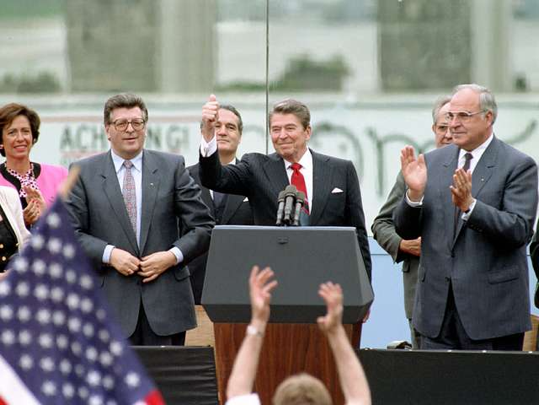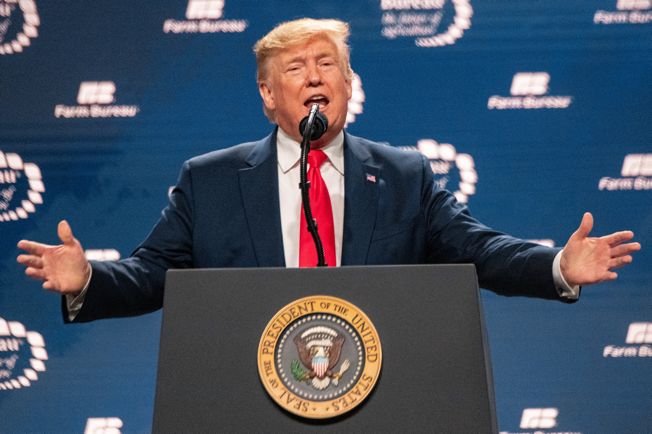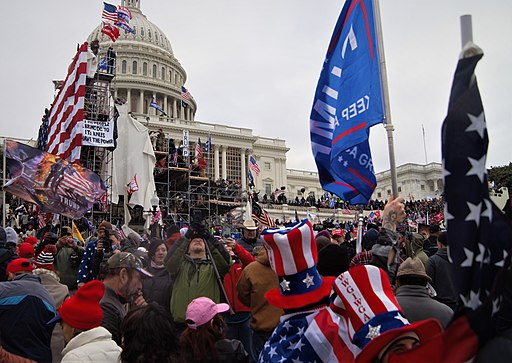32 Public Communication Analysis: Rhetorical Artifacts and Historical Context
Chapter Objectives
Students will:
- Identify an appropriate rhetorical artifact for a public communication analysis.
- Reconstruct the historical context for the rhetorical artifact.
What can you accomplish through speech? What does—or doesn’t—rhetoric have the power to do?

It’s tempting to name a popular (or notorious) speech—especially by a US president—and jump to its presumed effects. Some people may say, for instance, that President Ronald Reagan’s 1987 Brandenburg Gate speech (“Mr. Gorbachev, tear down this wall.”[1]) caused the Berlin Wall to come down. Or that then–Senator John F. Kennedy’s debating skills against President Nixon won Kennedy the 1960 election. Or that President Donald Trump’s January 6, 2021, rally speech caused the ensuing attack on the US Capitol.
These uses of rhetoric are well known, but did they produce these outcomes? If so, how? Perhaps more importantly, how did the rhetoric impact democracy? Did the rhetorical features in speeches strengthen or weaken the principles on which democracy depends as we introduced and outlined in chapter 31? An advocate can successfully achieve their speaking goals without necessarily strengthening democratic principles.
Public communication analysis is an approach to rhetorical criticism that helps critics determine a rhetorical artifact’s features and ascertain their likely consequences. It focuses on these central questions:
- Does the rhetorical artifact achieve the rhetor’s goal? How or why not?
- Does the rhetorical artifact strengthen or weaken democratic principles? How?
This approach expands and updates the traditional method of criticism known as Neo-Aristotelianism to address our interest in democracy and to include several more contemporary rhetorical concepts.
We see this critical approach as an important building block for you as a speaker and democratic participant. It is an approach that will cultivate your analytical sensibilities and enhance your understanding of public speaking fundamentals as you focus on how other rhetors have employed them.
In this chapter, we outline the principles of public communication analysis and give you the tools to set up a rhetorical critique. We will focus on the first two of four major steps: identifying an appropriate rhetorical artifact and reconstructing the artifact’s historical context. The next chapter will focus on analyzing the artifact through the final two steps: describing and interpreting the artifact and evaluating the artifact.
Box 32.1 Public Communication Analysis Steps
- Identify an appropriate rhetorical artifact.
- Reconstruct the artifact’s historical context.
- Describe and interpret the artifact’s rhetorical features.
- Evaluate the artifact’s effects in terms of achieving the rhetor’s goals and strengthening democratic principles.
Identifying a Rhetorical Artifact
Recall from chapters 30 and 31 that a rhetorical artifact is an object of study in rhetorical criticism. It is a specific instance of rhetoric that was produced for an audience at a particular time. To begin a public communication analysis, we recommend you choose an artifact that meets the criteria in box 32.2. We offer these criteria because public communication analysis best illuminates such artifacts. Rhetorical artifacts that more heavily use visual or audio symbols are typically better suited to different rhetorical methods, such as ideological criticism described in chapters 34 and 35.
Box 32.2 Guidelines for Selecting an Artifact for Public Communication Analysis
- The artifact should address a significant community concern or issue (i.e., focuses on a problem that a community cares about and that carries significant implications for that community’s welfare).
- Find an artifact that attempts to persuade an audience (i.e., not a purely informative artifact).
- The artifact should mostly use verbal symbols (i.e., uses more words/speech than images, music, etc.).
- The artifact you select should offer a single “voice” or manner of expression. Even if written by a group (such as a company), the artifact should express itself as an individual (i.e., the artifact should not be a group discussion, dialogue, or online exchange).
- Ideally, you should have a complete transcript of the artifact and, if relevant, access to audio or video of the artifact being delivered.
Recall that in chapter 30, we characterized rhetorical criticism as an act of civic engagement. Using public communication analysis will improve your ability to think critically about public messages, educate fellow members accordingly, and participate in democratic governance. As we explained in chapter 31, these outcomes are more likely, however, if you choose rhetorical artifacts that pertain to civic affairs (the first criterion in box 32.2) than to, say, a group’s hobbies or interests. Our preference for public speech that addresses significant community concerns aligns with others who have identified such rhetoric as particularly valuable for democratic participation. Box 32.3 provides examples.
Box 32.3 Public Speech Should Address Significant Community Concerns and Issues
Rhetorical practitioners and scholars have often deemed rhetoric that addresses substantive public issues as essential for maintaining a healthy democracy.

For instance, in 1919 as the Chautauqua circuits began to wane, the associate editor of The Century at the time, Glenn Frank, called on traveling lecturers to address the serious problems of the day in contrast to the then-popular lecturers “who tickle the fancy and flatter the prejudice of the crowd.” He claimed the best speakers “will be able to introduce the community to the facts and principles of some underlying problem of our national life; and…[they] will be able to answer questions from the crowd and to stimulate a genuine community discussion.”[2]
More recently, communication scholars Ferald Bryan and others have said the best public speeches are concerned with “worthy ideas to express, ideas that merit the attention and efforts of the speaker and the concern of the audience.”[3]
Appropriate artifacts for public communication analysis can take many forms, including speeches and public statements by officials, concerned community members, and protesters; editorials and letters to the editor published in newspapers and magazines; and even relevant blog postings and websites.
In this and the next chapter, we will focus on President Trump’s January 6, 2021, speech as a rhetorical artifact. We will use it to exemplify the steps of public communication analysis, beginning with explaining why it qualifies as an appropriate rhetorical artifact.
Box 32.4 President Trump’s January 6, 2021, Speech as a Rhetorical Artifact
A sample rhetorical artifact that meets the criteria is President Trump’s January 6, 2021, speech in Washington, DC.
- It addressed a significant community concern or issue: the validity and legality of the 2020 national election.
- Its goal was to persuade: President Trump attempted to convince audiences that the 2020 presidential election was “stolen” from him and that they needed to “save our democracy” and “take back our country.”[4]
- The speech primarily used words to communicate: Trump’s vocal and nonverbal delivery are important to consider, as is the visual setting and backdrop, but the speech mostly consisted of his words.
- It offered a single voice: While it was written with speechwriters (as is typical for speeches by US presidents), the final, delivered speech featured Trump’s voice and perspective—unlike, say, an interview that would also include the interviewee’s questions and viewpoint.
- It is relatively easy to find a complete transcript and video of the speech online.
Reconstructing the Historical Context
Once you’ve identified an appropriate rhetorical artifact, you need to reconstruct its historical context. We defined context in chapter 31 as the conditions or situation within which rhetoric is produced. In that chapter, we said that context addresses “who, why, what, to whom, when, and where surrounding the rhetoric’s production.” The answers to these questions help the critic determine how the context prompted and shaped the rhetoric. In this section, we briefly explain how learning about the historical context enhances your public communication analysis, and we return to President Trump’s January 6, 2021, speech to illustrate.
“Who?”
 Find out what audiences might have known about the rhetor (the “who”). In the previous chapter, we expanded the definition of rhetor to include the author(s) or creator(s) of the rhetorical artifact under examination. The rhetor’s public reputation at the time the artifact was produced, the rhetor’s position in society, and/or the rhetor’s background could have influenced what audiences expected from them.
Find out what audiences might have known about the rhetor (the “who”). In the previous chapter, we expanded the definition of rhetor to include the author(s) or creator(s) of the rhetorical artifact under examination. The rhetor’s public reputation at the time the artifact was produced, the rhetor’s position in society, and/or the rhetor’s background could have influenced what audiences expected from them.
Box 32.5 President Trump as the Rhetor of the January 6, 2021, Speech

President Trump first became famous in the United States in the 1980s as a millionaire real estate mogul, known for his lavish lifestyle and his 1987 book The Art of the Deal, a New York Times best seller. Starting in 2004, he regularly appeared on TV’s The  Apprentice and Celebrity Apprentice, which he coproduced and hosted until 2015.
Apprentice and Celebrity Apprentice, which he coproduced and hosted until 2015.
He successfully ran for president (for the first time) in 2016, using the campaign slogan “Make America Great Again.” During his four-year term, Trump amassed large groups of supporters—and critics—for his stances and policies on immigration, climate change, transgender people, and the COVID-19 pandemic and for his granting of pardons, to name a few.
The 2020 election proved a close race against former Vice President Joe Biden, taking several weeks for final votes to be tallied and Joe Biden to be declared the winner in both electoral votes (306 to Trump’s 232) and the popular vote.[5] During the time between that loss and his January 6 speech, Trump and his team sought to overturn the results through lawsuits and public appearances.
Therefore, audiences were likely very familiar with Trump when he spoke in early 2021 as a former real estate mogul and media celebrity and, more recently, as a controversial president.
“Why?” and “What?”
 Consider what prompted the artifact and the rhetor’s goal(s) (the “why”) as well as the type of artifact the rhetor created (the “what”). Typically, a rhetor’s goals and the artifact itself are responsive to the events, conditions, or forces that prompted the artifact’s creation. Knowing the reason or motivating cause for the rhetoric’s production, the speaker’s goal, and the type of artifact created (including its major characteristics) can help guide your analysis as you look for strategies the rhetor employed to respond to the provocation and attempt to achieve their goal.
Consider what prompted the artifact and the rhetor’s goal(s) (the “why”) as well as the type of artifact the rhetor created (the “what”). Typically, a rhetor’s goals and the artifact itself are responsive to the events, conditions, or forces that prompted the artifact’s creation. Knowing the reason or motivating cause for the rhetoric’s production, the speaker’s goal, and the type of artifact created (including its major characteristics) can help guide your analysis as you look for strategies the rhetor employed to respond to the provocation and attempt to achieve their goal.
Box 32.6 The Prompt for, and Goals and Account of, the January 6, 2021, Speech
- Why (Prompt): President Trump’s January 6, 2021, speech was provoked by the outcome of the 2020 national election with Joe Biden being chosen as the forty-sixth president.
- Why (Goal): He hoped to incite enough negative public reaction to convince Republican members of Congress and, especially Vice President Mike Pence, to reject the states’ certification of Electoral College vote counts.[6] The joint congressional meeting scheduled for January 6, where Congress would affirm the count, was the last legal step to confirm Biden as president.
- What: Trump delivered in person a nearly seventy-two-minute speech. His presentation addressed numerous subjects. Primarily, though, President Trump claimed the 2020 election results were fraudulent. He accused Democrats of committing the fraud and blamed the media for helping them. He promised his supporters that they would rectify the deception with the help of Vice President Mike Pence and other Republicans. Trump encouraged supporters to march to the Capitol to encourage these leaders to overturn the results.
“To Whom”
 Research the artifact’s audiences. Recall that in chapter 10, we differentiated the following:
Research the artifact’s audiences. Recall that in chapter 10, we differentiated the following:
- direct audience (those who are exposed to and attend to the rhetoric)
- target audience (those the rhetor hopes to reach)
- implied audience (those who are represented in the message)
- implicated audience (those who will be affected by the message if it is successful)
We also considered whether the audience is
- discrete (limited to those who show up for an event at a particular day and time) or
- dispersed (unlimited by location and/or time).
Such information can help you later analyze whether and how the artifact was adapted to these audiences. We discussed audience analysis and adaptation in chapters 10 and 11.
Box 32.7 The Audiences for the January 6, 2021, Speech
President Trump’s direct audience included those in the discrete audience who joined his “Save America” rally in person at the Ellipse, a park near the White House in Washington, DC. His direct audience also included dispersed viewers who watched the speech live (or later recorded) on C-SPAN or PBS NewsHour. Trump likely recognized that while he could target his message at supporters, his speech would also be heard and viewed by critics and advocates of Joe Biden. These Biden supporters, as well as Pence and other Republican congressional leaders, composed Trump’s implied and implicated audiences—those referenced by his message and impacted if his speech was successful.
“When?”


Consider the timing of an artifact (the “when”). Timing includes both the specific date and time for the artifact and the time period in which the rhetoric was situated. The latter is important to consider because communities may think and talk about public issues differently over time as new problems, information, and perspectives emerge.
Box 32.8 The Timing of the January 6, 2021, Speech
President Trump delivered his speech on January 6, 2021, at 12:00 p.m. EST. The time period of this speech is important, especially as we look back years later. His claims about what would or should happen if he was not elected president rang differently in the lead-up to the 2020 election compared to before the 2024 national election.
Before the January 6 attack on the US Capitol, Trump’s encouragement to “take back our country” or “fight” seemed more like fiery metaphors than literal instructions to inspire voter turnout.
After the attack, however, Trump’s comments sounded more literal since we know what happened after his speech. The physical attack on the Capitol also colored his later threats—such as at a March 2024 rally, where he said “It’s going to be a bloodbath for the country” if he didn’t win that election.[7] In light of January 6, such rhetoric sounded more nefarious or potentially threatening (and was criticized as such).
Whether you think Trump’s rhetoric contributed to the January 6 attack or not, a critic studying Trump’s January 6 speech would need to differentiate between audience members who heard the speech live and audiences who watched a recording of the speech later (after the Capitol attack occurred), since their responses might differ accordingly.
“Where?”
 Reflect upon an artifact’s location (the “where”) to help you later analyze how the rhetor adapted to it. Location can include the following:
Reflect upon an artifact’s location (the “where”) to help you later analyze how the rhetor adapted to it. Location can include the following:
- the specific place the rhetor delivered or disseminated the artifact (e.g., the geographic location and/or actual building or street)
- the medium by which the rhetor distributed the artifact (e.g., face-to-face, television, YouTube, newspaper, online blog)
All locations pose limitations on and offer opportunities for how a rhetor can most effectively present their message. In chapter 10, we touched on the environmental factors a speaker must adapt to, such as the time of day, audience size, and communication medium, and we suggested ways a speaker may adjust to them.
Box 32.9 The Location of the January 6, 2021, Speech
The location for President Trump’s January 6 speech gave him challenges and opportunities. It’s difficult to hold a large crowd’s attention for long, especially when speaking in person outside on a cold January day. At one point, Trump worried, “I hope you don’t get bored,” and he later acknowledged, “It’s freezing out here.”
Trump was also being broadcast, and the rhetorical choices a speaker might make for the immediate physical conditions—such as speaking more loudly, talking directly to the immediate crowd, and trying to keep them fired up—may not translate well to television viewers who are experiencing the speech differently.

Yet Trump could take advantage of the physical setting. The Ellipse is a grassy area between the White House (which could be seen behind Trump) and the Washington Monument. It butts into the National Mall and is just a few blocks from the US Capitol, where Congress would convene one hour after Trump began his speech to approve the Electoral College’s votes. At one point, Trump even said, “Right over there, right there, we see the event going to take place.” So in addressing the crowd, Trump could capitalize on their physical proximity to the Capitol to help stress the urgency of the moment and the importance of walking to the building after the speech.
Reconstructing an artifact’s context helps the critic determine whether and how the artifact achieved the rhetor’s goal(s). The context explains the pressures, influences, and/or problems addressed or negotiated through the artifact, which can enable the critic to better understand how the artifact functioned in that moment. This is also particularly important when considering the artifact’s impact on democratic principles, which we discussed in the previous chapter. While we can talk about democratic ideals in general or broad terms, a community defines, prioritizes, and enacts those principles in relation to a specific issue at a particular moment in time.
Box 32.10 Questions to Ask About Historical Context
- What might the audience have known about or expected from the rhetor?
- What prompted the rhetor to produce the artifact?
- What was the rhetor’s goal(s) for the artifact?
- What type of artifact did the rhetor produce? What medium did it use?
- Who were the audiences for the artifact, and how did the rhetor need to adapt to them?
- What was the timing of the artifact?
- What was the artifact’s location, and what restrictions or opportunities might that have created for the rhetor?
Contextual information informs the critic’s analysis of the artifact as they interpret how the artifact was shaped by and helped shape its context. In the next chapter, we will turn to analyzing the artifact itself by providing instruction on the next two steps of public communication analysis.
Summary
Public communication analysis is an approach to rhetorical criticism that enables you to determine whether and how a rhetorical artifact achieves its goals and whether and how it strengthens democratic principles. The approach assumes that rhetoric that addresses public issues should strengthen democracy. This chapter provided the first two methodological steps necessary to conduct such an analysis.
- You begin by identifying a suitable rhetorical artifact. For public communication analysis, such an artifact must address a significant community issue or concern and should be persuasive, verbal, and expressed in a single voice.
- You then reconstruct the historical context for the artifact by discovering what the audience might have known about the rhetor; what prompted the artifact and the rhetor’s goal(s); the type of artifact developed and its medium; the audience(s) exposed to the artifact, targeted by the artifact, referenced in the artifact, and impacted by the artifact if its message succeeds; and the artifact’s location and timing.
Key Terms
location
public communication analysis
timing
voice
Review Questions
- What kinds of rhetorical artifacts are best suited to public communication analysis?
- Which aspects of an artifact’s context should you discover? Why?
- What does an artifact’s location and timing refer to?
Discussion Questions
- How can you find a transcript of a rhetorical artifact? How might you create one if it doesn’t already exist? What software might be helpful?
- What opportunities and limitations do you think each of the following media poses for rhetors: in-person speech, television broadcast, social media post, online blog, social media post?
- Do you think artifacts always develop in response to preexisting issues, or can rhetors create the perception of issues that need responding to through their artifacts? Can you think of instances of public discourse for each?
- Ronald Reagan, “Remarks on East-West Relations at the Brandenburg Gate in West Berlin" (transcript, West Berlin, Germany, June 12, 1987), Ronald Reagan Presidential Library & Museum Archives, https://www.reaganlibrary.gov/archives/speech/remarks-east-west-relations-brandenburg-gate-west-berlin, archived at https://perma.cc/32J4-PSKV. ↵
- Glenn Frank, “The Parliament of the People,” The Century 98 (1919): 416. ↵
- Ferald J. Bryan, R. R. Allen, Richard L. Johannesen, and Wil A. Linkugel, eds., Contemporary American Speeches, 10th ed. (Dubuque, IA: Kendall Hunt, 2010), 2, 4. ↵
- Donald Trump, “Speech at Rally Before US Capitol Riot” (transcript, Washington, DC, January 6, 2021), Associated Press, https://apnews.com/article/election-2020-joe-biden-donald-trump-capitol-siege-media-e79eb5164613d6718e9f4502eb471f27. ↵
- “Presidential Election Results: Biden Wins,” New York Times, November 2020, https://www.nytimes.com/interactive/2020/11/03/us/elections/results-president.html. ↵
- According to the Final Report of the Select Committee to Investigate the January 6th Attack on the United States Capitol, Trump “pressured Vice President Pence to obstruct the joint session of Congress on January 6th, falsely claiming that he had the power to refuse to count certain electoral votes. President Trump knew this was illegal but attempted to justify it with lies about the election.” U.S. House of Representatives, 117th Cong., 2nd sess., Final Report of the Select Committee to Investigate the January 6th Attack on the United States Capitol (Washington, DC: U.S. Government Publishing Office, 2022), https://www.govinfo.gov/content/pkg/GPO-J6-REPORT/pdf/GPO-J6-REPORT.pdf, archived at https://perma.cc/9EAM-SMZ8. ↵
- Donald Trump, “Donald Trump Speaks at Rally in Ohio” (transcript, Dayton, OH, March 16, 2024), Rev, https://www.rev.com/transcripts/donald-trump-speaks-at-rally-in-ohio, archived at https://perma.cc/EHX2-RNFZ. ↵

